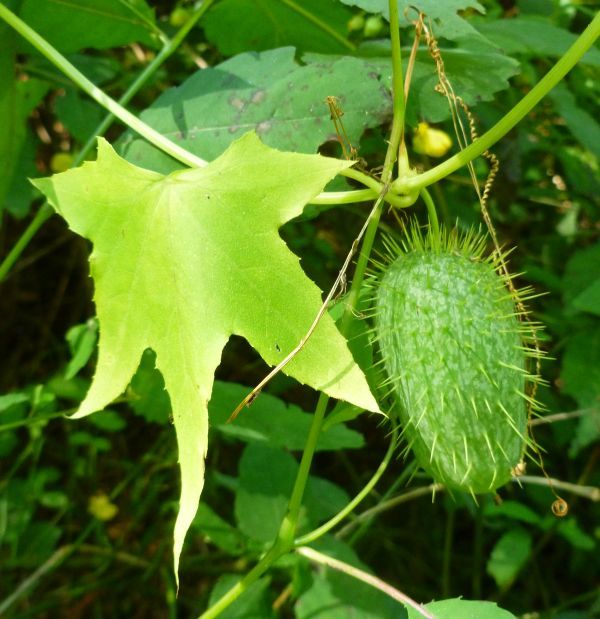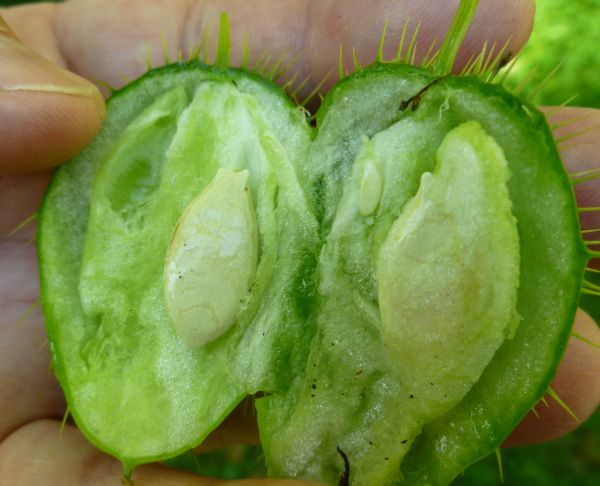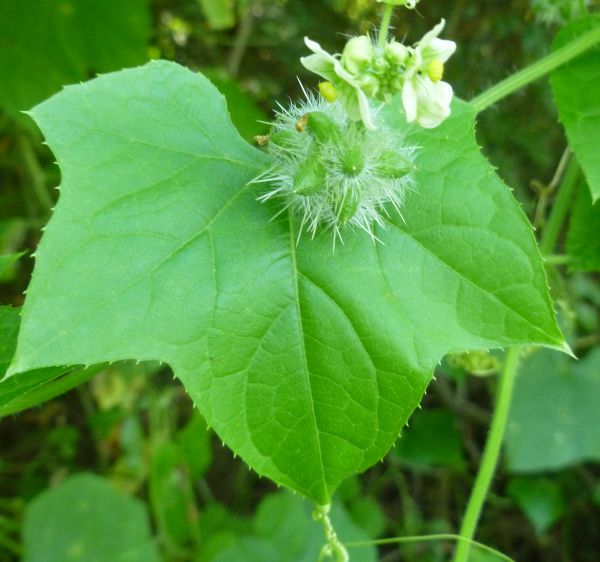
Pumpkins, zucchini, yellow squash, gourds, the members of the Cucurbitaceae family are ripe and ready to eat in North America.
In Pennsylvania’s moist thickets you’ll also find wild and bur cucumbers … but don’t eat them!
Wild cucumber (Echinocystis lobata) is an annual vine that can be unruly at this time of year. After a summer of growing, climbing and blooming it has thrown its tendrils around trees and over bushes. Its spiny cucumber fruits hang at intervals along the vine waiting to dry out and explode the seeds in all directions.
The seeds take up a big part of the fruit as you can see from this sliced one. I wonder if any animals eat this…
A look-alike plant with even smaller, spikier fruits is the Bur cucumber (Sicyos angulatus). Its clustered “cucumbers” aren’t edible and frankly look dangerous because the ratio of spines to fruit is a lot higher.
Newcomb’s Wildflower Guide separates these plants by their flower parts but there are other hints as well:
- Wild cucumber has six petals, Bur has five.
- Wild has smooth stems. Bur has sticky hairs on its stem.
- Wild has deeply lobed leaves. Bur has broad, heart-shaped leaves.
- Wild’s fruits hang separately. Bur’s fruits are in clusters.
- Wild’s fruits are about the size of the leaves (can be 2″). Bur’s fruits are small.
Dianne and Bob Machesney found the wild ones at the Butler-Freeport Trail and burs at Green Cove in Washington County.
If you want to eat a cucumber, go for the real thing in the garden or grocery store. It’s been cultivated for 3,000 years.
(photos by Dianne Machesney)
Wild Cucumber is one of my favorite vines…the scent of the flowers is heavenly. I’ve found it growing in Boyce Mayview Park. I would love to try to get it to grow in my yard. I’ve never seen the Bur Cucumber, so I’ll have to be on the look out for it.
My son just bought a house in the Morningside area of Pittsburgh and I was helping him clean up around the house. In the front yard I found a bur cucumber vine completely covering and choking a large beautiful fire bush nearly to death. I rescued it just in time. I had never in my life encountered such a plant and was totally unprepared for its disgusting thorny bristles that actually stuck to and went through my gloves! I finally used multiple sheets of newspaper to grab and rip out the vines. This is a horrible and invasive weed! I can hardly believe that I actually saw bur cucumber seeds for sale on a couple websites! It should not be grown or encouraged to grow, because if left go it would completely choke out all other vegetation near it.
bur cucumber is 90% water. pull the root,very easy to do,and in 24hrs the vine is gone.
I have grown a bur cucumber plant on an arbor for about 10 years now. I love it, but you have to know about it. Yes, it self seeds hundreds of plants every spring. If you don’t pull up every plant, but one, in the spring, you would be overgrown fast. They pull up very easily. I do it when they are a couple of inches tall. It makes beautiful vines that I love to train to do my bidding. But now, when it grows the seed pods, you have to cut it down while the pods are green. I let a few turn brown and harvest them to plant. But if you wait till they are brown, your hands WILL have nasty spikes in them, even with leather gloves.
I’m sorry but it is not “invasive”. It is a native plant. Yes it can be problematic to our gardens and other lawn plants, but it does deserve to be let alone in natural settings.
It’s good for bee’s we need bee’s
Comments on this blog are moderated. Rather than remove this comment it has been edited for tone.
You cut down a native fruiting vine, which supports dozens of creatures, in favor of a legally listed invasive bush.
I got a bur cucumber mixed in with my annual purchase of acorn squash plants and regular cucumber plants. I was wondering why it climbed almost 30 feet into a tree and did not produce yellow flowers. Then I saw the tiny 5 lobed flowers, googled it and found out what it really is. It has a truly spectacular growing habit but I cannot rip it out yet as it is all mixed in with my edible stuff. I feel like getting some seed on line and spreading it all over the garden center, where they gave me this thing.
Bur cucumber fruit absolutely is edible. Harvesting carefully, bending the spines as you grab the cluster, can be done without gloves. The spines are easily ground up by chewing, but it’s best to soften them by blanching. The taste of the fruit is subtle, but it’s distinctly a cucumber flavor (kind of like wild strawberries have a subtle taste of strawberry).
Nevertheless, a spine can puncture your mouth and cause irritation if you aren’t very careful when chewing bur cucumber fruit–so I classify it as a survival food rather than something I would forage for everyday use.
Can I eat bur cucumber?
Sara samartino, I don’t know the answer to your question.
My mom has this vine all over her farm. Hard to get rid of. We hate it.